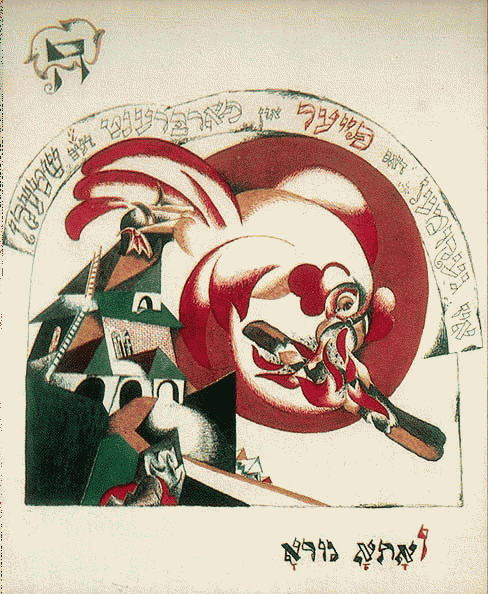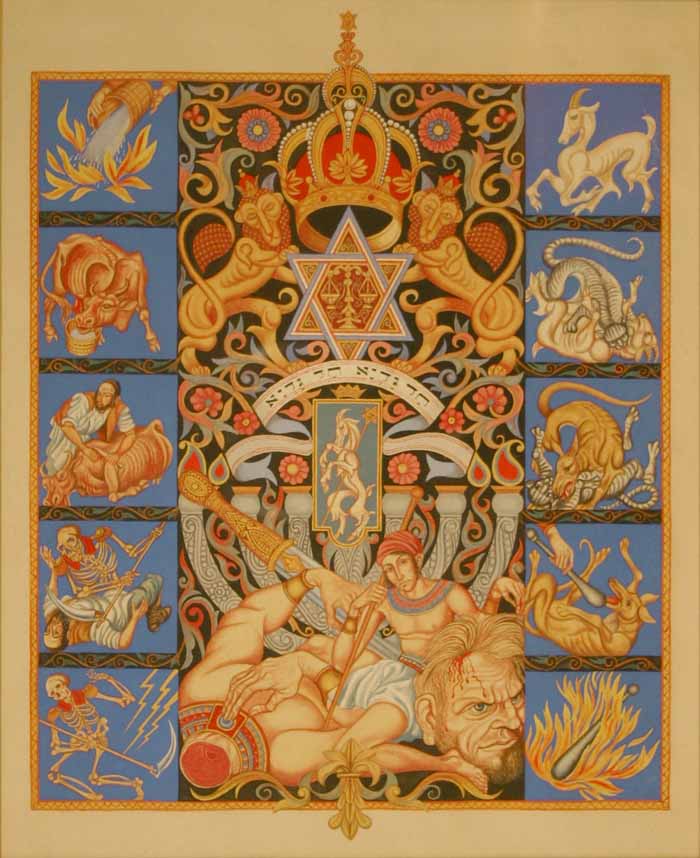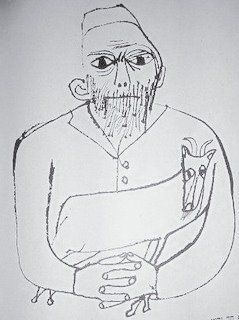One Only Kid
"Chad Gadya" [One only kid]

"Chad Gadya" is a cumulative song which is sung at the end of the Passover seder. It tells a story in each stanza of which another detail is added to what has come before: the kid is eaten by a cat which is bitten by a dog which is beaten by a stick which is burned by a fire which is put out by water which is drunk by an ox which is slaughtered by a ritual slaughterer who is killed by the Angel of Death who is killed by God.
The song "Chad Gadya" was first incorporated into the Prague Haggadah [the text for the seder ritual] in 1590, together with the second last song "Echad mi yodea?" [Who knows one?], although both songs existed centuries before they were first connected to the seder, and the Jewish origins of "Chad Gadya" may even be pushed back as far as the thirteenth century.2 It was never part of the Yemenite ritual, and a Ladino version of the song – "Un cavretico" – was only added to Sephardic haggadot from the beginning of the twentieth century. "Chad Gadya" is sung in many different languages by Jews around the world: here are Ladino, Arabic, Bukharan, Libyan, Tunisian and Polish versions.
Musicologist Abraham Schwadron spent ten years collecting hundreds of versions of "Chad Gadya" from Jewish communities around the world. The collection is housed in the American Folklife Center of the Library of Congress, and a disk of 25 of these recordings is available from Folkways. Voice of the Turtle, a group which specializes in Ladino music, also produced a disk - "A Different Night" - of their own interpretations of "Chad Gadya" as well as other seder songs, based upon the Schwadron collection and other sources. Performances of "Chad Gadya" by Jewish communities around the world may be heard on the "Invitation to Piyut" website.
According to Ruth Rubin: "Chad Gadya" is mentioned in Cervantes' Don Quixote, Arnim and Brentano included it in their collection Des Knaben Wunderhorn, Heinrich Heine makes Jakel the Fool chant it in "The Rabbi of Bacharach", and Israel Zangwill uses it effectively in "Dreamers of the Ghetto".
Related folksongs
There are several European folksongs which incorporate the sequence of the cat/dog – stick – fire – water – ox– butcher, and parallels may be found in Persian and Indian sources, as well (Jewish Encyclopedia). A German folksong, "Der Herr der Schickt den Jokel aus" [The master who sent the peasant out], which in turn was based upon an old nursery song from Provence, tells about a farmer (or peasant/Jack/Yekele/yokel) who refuses to harvest apples (or pears) until he is finally persuaded to do so following a series of events leading up to a higher force such as the Devil. A variant of this song was recorded by the Grimm Brothers and several Yiddish versions of this song have been recorded by Schwadron.
Where does the "kid" come in? Here it is, in a French folksong, "Ah! Tu sortiras, Biquette", about a very stubborn little goat who refuses to get out of the cabbage patch. Watch the following really cute video. Another French/Catalan folk story featuring the same sequence is "La Petite Fourmi qui Allait à Jérusalem" [The little ant that went to Jerusalem]. One of the readers of this webpage, Michal Mynar, has also sent in this humorous Czech song: Jora de na pivo. A Greek song, "Dili Dili, to Kandili [Flicker, Flicker]", begins with a girl sewing to the light of a lantern, which a rat puts out!
Jewish sources
The basic imagery of all these variant folksongs is that of ever-increasing power, while the moral varies from culture to culture. The Jewish message underlying "Chad Gadya" is that there is a chain of cause and effect – those who destroy will themselves be destroyed – and that in the end justice will prevail and God will triumph. This message has, in fact, been expressed in midrashim [homiletic teachings] relating to our very earliest Biblical stories, such as the one concerning the struggle between the patriarch Abraham and King Nimrod in Bereshit Rabba 38: "Nimrod suggested to Abraham that since he had refused to worship his father's idols because of their want of power, he should worship fire, which is very powerful. Abraham pointed out that water has power over fire. 'Well,' said Nimrod, 'let us declare water god.' 'But,' replied Abraham,' the clouds absorb the water and even they are dispersed by the wind.' 'Then let us declare the wind our god.' 'Bear in mind,' continued Abraham, 'that man is stronger than wind, and can resist it and stand against it.' Nimrod, becoming weary of arguing with Abraham, decided to cast him before his god – fire – and challenged Abraham's deliverance by the God of Abraham, but God saved him out of the fiery furnace." (To learn more about the struggle between Abraham and Nimrod, see the lecture on "Kings and Queens": "Cuando el rey Nimrod").

El Lissitzky - "And then came the fire ..."
Another source dealing with the concept of strength relates to the giving of charity, which Jewish tradition views as the strongest force in the universe, even greater than death itself: "Rabbi Judah used to say: Ten strong things have been created in the world. The rock of the mountain is hard, but iron cleaves it. Iron is hard, but fire softens it. Fire is powerful, but water quenches it. Water is heavy, but clouds bear it. Clouds are thick, but wind scatters them. Wind is strong, but a body resists it. A body is strong, but fear crushes it. Fear is powerful but wine banishes it. Wine is strong, but sleep works it off. Death is stronger than all, yet charity delivers from death. As it is written, 'Charity (righteousness) delivereth from Death' ("Proverbs" 10:2)." -- (Bava Batra 10a). (Diamant).
The song "Chad Gadya" has been interpreted allegorically in many ways 3, from the historical as well as religious points of view. The most common interpretation is that the "only kid that father bought for two zuzim" represents the Jewish people, acquired by God at Sinai with the two tablets of the Law (or, alternatively, through the agency of Moses and Aaron). The other characters personify nations that successively oppressed Israel, each being overthrown in its turn by a new tyranny. Assyria or Babylonia (the cat) fell to Persia (the dog), which succumbed to Greece (the stick), which was swallowed up in the Roman Empire (the fire); Rome fell to the Barbarians (the water), who were vanquished by the armies of Islam (the ox), which yielded to the Crusaders (the slaughterer). Finally, the Angel of Death represents the latest conqueror or persecutors whom God will bring to account. (Jewish Encyclopedia). There are many other interpretations: for example, the Gaon of Vilna viewed each stage in the song as a manifestation of the battle between Yaakov and Eisav over the blessings of their father Yitzchak. R. Nasan Adler (18th century) taught that "Chad Gadya" is a warning against lashon hara [gossip] (Kaplan), and R. Yaakov Emden sees "Chad Gadya" as "a personal odyssey of self development" (Brander). (Read Kaplan and Brander for even more interpretations).

"Chad Gadya", from the Szyk Haggadah
Songs and poetry based upon "Chad Gadya"
"Chad Gadya" has inspired the composition of many poems and songs in Yiddish and in Hebrew, especially since the 1930's.
(a) Yiddish Songs
A well-known poem by Manger, "Dos lid funem tsigele" [The song of the kid], plays upon one of the metaphoric meanings of the term "chad gadya", signifying "prison": the kid is locked into the restraints imposed by Jewish tradition. Before, during and after the Holocaust, many poems, notably by H. Leyvik and Ch. Grade, utilized the image of the kid as victim. (For a detailed account of how the kid of both "Chad Gadya" and "Rozhinkes mit mandlen" has been treated in subsequent literature, I highly recommend this article by Menashe Geffen [in Hebrew])
"Chad Gadya" of the Haggadah has also been reworded into children's songs. Some are conventional paraphrases, such as the one by Yitskhok Pirozshnikov in the video below, while others have been secularized: the apex of Gelbart's song, for example, is the shokhet [butcher] rather than God.
Yiddish folk-song based on the "Chad Gadya" theme
(b) Hebrew Songs
Secular kibbutzim have long sought to interpret and renew musical ritual in traditional Jewish festivals. "Chad Gadya", in particular, is continually being paraphrased and set to music, with communal seders culminating in inventive musical performances of the song. For Hebrew readers, I highly recommend the fascinating and comprehensive five-part account by Einat Amitay of how "Chad Gadya" is portrayed in kibbutzim. One of the most well-known "Chad Gadya" songs was written by Binyamin Caspi in 1933 4; it has been set to music several times, most popularly by Moshe Bik and also by Nachum Nardi, both versions of which may be heard on the Hebrew-song site, Zemereshet. Caspi's text ends with the words: "In the heavens a voice calls out: Let there be an end to evil ... and let there be peace in the world." More recently, "Chad Gadya" has been rewritten to the beat of rock-blues by Manolo Kleinhaus; the video below was filmed at Kibbutz Ma'abarot, where seders have been known to draw crowds of 1000 visitors! Kleinhaus' text ends with God deciding to re-create the world from the beginning, "this time without any errors!"
1) "Chad Gadya" by Caspi-Bik; 2) "Chad Gadya" by Kleinhaus
Caspi's and Kleinhaus' texts are basically paraphrases with idiosyncratic endings. However, a completely different "Chad Gadya" song - "Al geva ram" / "On a high hill" - was written for children by Levin Kipnis in 1944, engaging the stock characters in a beautiful vision of utopia rather than a chronicle of evil.
Kipnis' song, with an introduction in Hebrew by his son, Shai
The "chad gadya" symbol has been used for political satire and political protest. The former is a version written by Dan Almagor and set to music by Moshe Wilensky after Ben Gurion decided to evacuate the Sinai Peninsular after the Sinai campaign, in 1956. Read the story and listen to the song here.
The traditional meaning of "Chad Gadya" was also transformed radically by popular singer Chava Alberstein. Her protest "Chad Gadya" song 5 parodies the conventional image of Jew as victim, implying that Israeli society has changed from oppressed to oppressor. For a detailed account of the circumstances underlying this song, see the article by Seroussi & Ronen: "Had Gadya in Israeli Culture".
Alberstein's song sung in Arabic and Hebrew by the Rana choir
Anomalies
One of the anomalies regarding "Chad Gadya" concerns the fact that it was translated into (faulty) Aramaic, long after this language had ceased functioning as a Jewish vernacular. (Weiss; Szmeruk). Another anomaly concerns the bottom of the ecological scale: should we be singing about a goat or a mouse? (This problem doesn't exist in an early version of the song from Provence 6). In a well-known Italian song, "Alla fiera dell' est" [At the eastern fair] by Angelo Branduardi, the main character is, in fact, a mouse and not a goat. (See Seroussi & Ronen for more details. Note that Alberstein used this melody for her protest song). There is a mouse in a 15th-16th century German Haggadah, but it eats the goat! (Kulp). Actually, most folksong parallels only include a cat if there is also a mouse (or rat). In Jewish tradition, it is the kid which is associated with sacrifice, and thus most appropriate to be positioned at the beginning of a chain of violent events.
Regardless of the anomalies, it is the "illogical" version featuring the cat eating the goat which most communities sing so enthusiastically every year. I personally am intrigued by what this kid means in Jewish culture and folksong and will be developing this thought in the lecture. Hope to see you there!
1 See the page "Mothers and Fathers" for a more extensive discussion and reference list regarding Jewish lullabies.
2 The history and interpretation of "Chad Gadya" has been the subject of extensive research since the nineteenth century. The most comprehensive among recent studies is an article by Menachem Zvi (Harry) Fox. The content of Fox’s article was digested in English, updated and amended by Joseph Tabory. (See Seroussi & Gonen, below).
3 Allegorical Interpretations of "Chad Gadya"
(copied from Schwadron Folkways disk: linear notes)
1. | A. The kid | a. Israel - the ancient and modern nations |
|
| b. The oppressed Jewish people in the Diaspora |
|
| c. The scapegoat in the legend of Abraham's sacrifice of Isaac |
| B. The father | God |
| C. Two zuzim | a. Two ancient coins |
|
| b. Moses and Aaron |
|
| c. Mysticism of body and soul |
|
| d. Ancient kingdoms of Israel and Judea |
|
| e. Legend of Abraham and Nimrod |
|
| f. Two tablets of the Ten Commandments |
2. | The cat (fox) | Assyria |
3. | The dog | Babylonia |
4. | The stick | Persia - under Cyrus, the defeat of Babylonia, liberation from captivity and rebuilding of the Jerusalem temple |
5. | The fire | Macedonia |
6. | The water | Rome |
7. | The ox | Saracens - who conquered Palestine |
8. | The shochet | a. Crusaders |
9. | Malach Hamavet | a. Turkey - rulers over Israel |
10. | Kadosh | a. Literal reference to the all-encompassing power of the Almighty God |
4 Caspi's text, beginning "Ha'azinu chevraya" [Listen, folks], is often erroneously attributed to Leah Goldberg. Moshe Bik is believed to be the composer of the most popular melody, but this hasn't been proved definitively. (See Zemereshet; a comment by Eliahu Hacohen, in Hebrew; and the blog by Einat Amitay, below, also in Hebrew).
5 See how this has been used in Amos Gitai's film "Free Zone", starring Natalie Portman.
6 An early version of "Chad gadya" found in a manuscript from 13th – 14th century Provence features a more logical series of events than the one we sing traditionally (see the words in bold). The song in this manuscript was not connected to the seder, and its ending was not preserved. (Kulp)
One goat which my father bought for two zuzim, one goat.
And a dog came and ate the goat …
And a stick came and hit the dog …
And a fire came and burned the stick …
And water came and extinguished the fire …
And an ox came and drank the water …
And a rope came and tied up the ox …
And a mouse came and ate the rope …
And a cat came and ate the mouse …
References:
Adler, C., Kohut, G., & Cohen, F. Had Gadya. Jewish Encyclopedia.com
Amitay, E. (2011). "Chad Gadya". Tarbut-Yeladim Blog [5 entries]. (In Hebrew)
Apple, R. Chad Gadya - Not a childish rhyme at all. OzTorah.
Armistead, S. & Silverman, J. A Judeo-Spanish cumulative song and its Greek counterpart.
Backer, A. Motivn fun tsig un tsigele. Steven Spielberg Digital Yiddish Library, 1987.
Brander, K. An analysis of Had Gadya. Yeshiva University Torah Online: Pesach to-Go.
Cohen, B. The peirush of the Vilna Gaon on Chad Gadya. Learning Torah.org
Diamant, A. Social action aspects of death and mourning. My Jewish Learning.
Fox, Menachem Zvi, “On the history of the songs ‘Ehad mi yode’a’ and ‘Had Gadya’ in Israel and among the nations,” Assufot: Annual of Jewish Studies 2 (5748[1988]), 201-226 (in Hebrew).
Geffen, M. Mitachat la'arisah 'omedet gediyah [Under the cradle stands a kid]. Tel-Aviv: Sifriyat Po'alim, 1986, pp. 12-86 [in Hebrew]
Hip Haggadot: Modern illustrated stories of Passover
Invitation to Piyut. Performances of "Chad Gadya" by various Jewish communities
Jewish Heritage Online Magazine. Had Gadya.
Kaplan, L.D. Chad Gadya: Deep meanings? On Sophia Street.
Knapp, A. (2010). “The little goat meets the little chicken: parallels between two celebratory songs in the Jewish and Bukharan traditions,” Across Centuries and Cultures, pp. 57-73.
Krasney, A. From cradle to sacrifice: On the transmutation of a song. The Mendele Review, Vol.2, Issues 32 & 33, 1998.
Krasney, A. The Jewish Mother Sings a Lullaby. 2012
Kulp, J. Commentary to The Schechter Haggadah, Schechter Institute of Jewish Studies, Jerusalem, 2009
Rayner, J. "Chad Gadya". In An Understanding of Judaism. Berghahn Books, 1997, p.114.
Schwadron collection: Chad Gadya - Passover Chant. Folkways
Rubin, R. (1973). Voices of a people: The story of Yiddish Folksong. C.17: Folksong - A universal language.
Seroussi, E. & Ronen, O. (2014). Had Gadya in Israeli Culture. The Hebrew University of Jerusalem: Jewish Music Research Center.
Szmeruk, C. The earliest Aramaic and Yiddish version of the "Song of the Kid" (Khad Gadye).
Tabory, Joseph. “The Haggadah and its Ritual,” included in the JPS Commentary on the Haggadah (Philadephia 2008, pp. 67-69).
Voice of the Turtle - "A Different Night: A Passover Musical Anthology". CD booklet.
Weiss, S. Sing a song of Passover. Klezmershack.com



